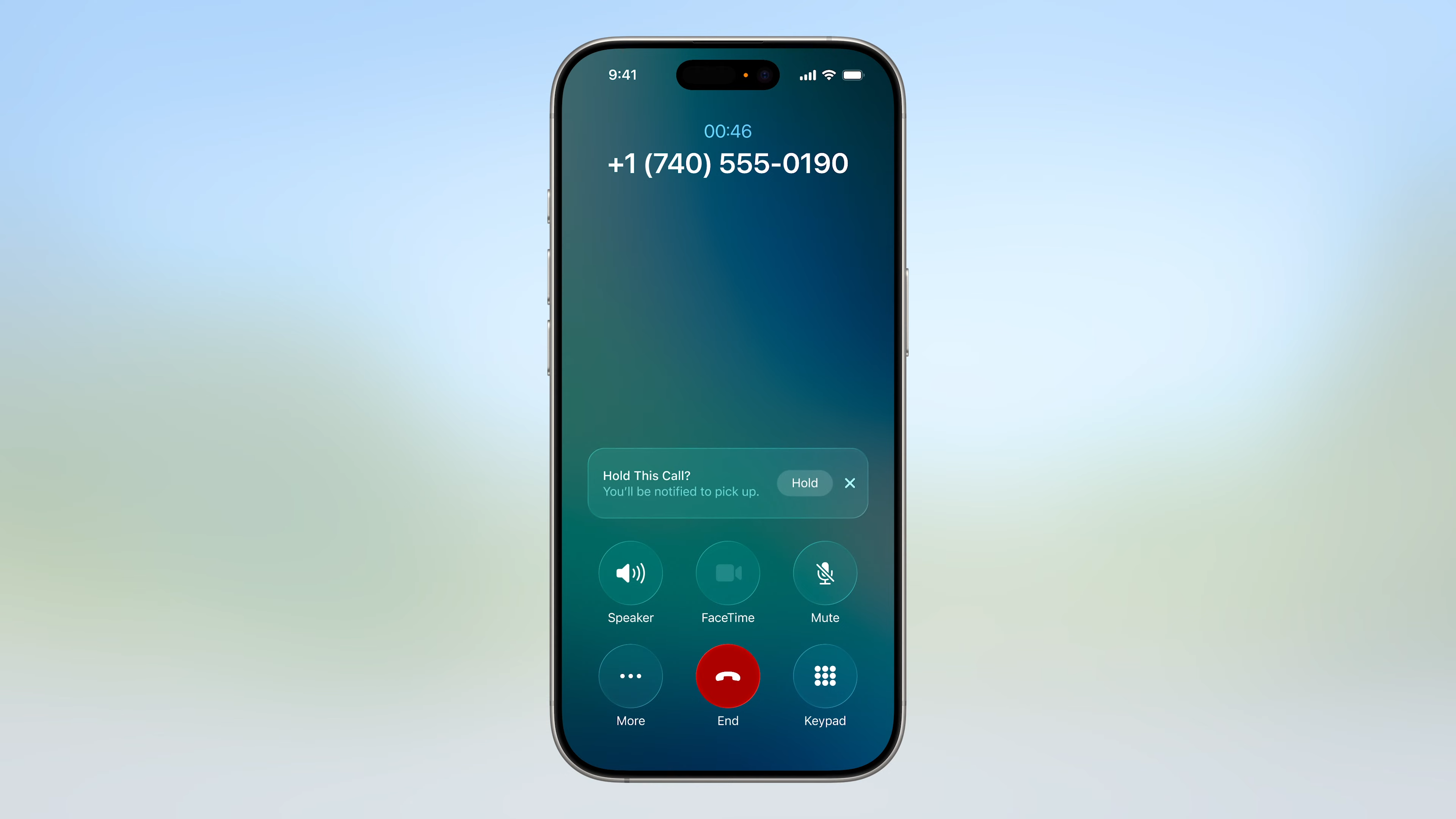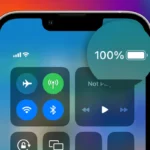Apple’s iOS 26, unveiled at WWDC on June 9, 2025, introduces a wave of AI-powered features to the Phone app that reimagines how users handle incoming calls, wait times, and voicemail management. These enhancements are part of Apple’s broader push to integrate more intelligence and utility into everyday experiences—without overcomplicating them.
Here’s a look at the standout features and what they mean for iPhone and iPad users.
Call Screening Built In
Apple is finally bringing native call screening to the iPhone. Building on Live Voicemail, iOS 26 introduces real-time Call Screening for unknown numbers. When an unidentified caller reaches out, your iPhone prompts them to state their reason for calling before it even rings on your end.

You’ll see a live transcription of their message, allowing you to choose whether to pick up, let it go to voicemail, or block the number entirely. It’s like a smarter gatekeeper—no third-party apps required.

This is Apple’s direct response to Google’s Pixel Call Screening, which has led the industry for years. While Apple doesn’t offer a voice-based AI responder like Google Assistant, their focus on privacy-first, on-device processing keeps all transcripts securely on your iPhone.

Hold Assist: No More Elevator Music

We’ve all been there—stuck on hold while trying to reach customer service. With Hold Assist, your iPhone can now wait for you. If you’re placed on hold, Hold Assist stays on the line, listens for a human to return, and then notifies you once someone picks up.

It’s part of Apple’s broader AI initiative in iOS 26, and it’s designed to save time and reduce stress. This feature is especially handy for frequent travelers, tech support callers, or anyone dealing with call centers.
Unified Call View

The Phone app gets a visual overhaul in iOS 26. Rather than juggling tabs for Favorites, Recents, and Voicemail, everything is now integrated into one continuous scrollable feed. You can still switch back to the traditional layout, but this unified view makes it faster to manage and revisit calls and messages.

Think of it as the Apple Music-style redesign for your calls: clean, efficient, and context-aware.
Context-Aware Intelligence and iPad Expansion
Apple is also bringing these features to iPadOS 26, letting users make and receive calls directly from iPads, now with full support for Call Screening, Hold Assist, and the new Phone UI. This move makes the iPad a more viable communications tool in home or business environments.
According to earlier reports from Bloomberg’s Mark Gurman, Apple has been quietly testing a range of AI-infused call features, including potential spam detection and dynamic call routing—some of which may appear in smaller updates later in the iOS 26 cycle.
Why It Matters
- Fewer spam interruptions: The new screening tools help cut down on robocalls and unwanted interruptions without silencing real contacts.
- Time-saving automation: Hold Assist handles the wait for you—perfect for multitaskers.
- More intuitive UI: The unified layout brings efficiency to your call logs and voicemail.
What’s Missing (For Now)
While iOS 26 is a huge step forward, it still lacks an AI-powered answering assistant like Google’s Duplex, which can interact with businesses for you. Apple may be holding off on full conversational AI for privacy reasons—but this gap might be addressed in a future update or even iOS 27.
iOS 26’s new Phone app features aren’t flashy—but they are practical, time-saving, and deeply useful. As Apple quietly retools how we interact with phone calls, it’s doing what it does best: simplifying everyday tech in a way that just works.
Tips To Stop Robocalls Once and For All
Are you tired of getting unwanted calls from robots at all hours of the day? Those annoying robocalls interrupt dinner, wake you up, and waste your time. The good news is that you can fight back with just a few taps on your phone. Both iPhone and Android devices have built-in features that let you block specific numbers instantly.
Blocking unwanted callers is easier than you might think. On an iPhone, you can block numbers through the Phone app by tapping on the info icon next to a recent call and selecting the block option. Android users can follow a similar process by opening their Phone app, finding the number they want to block, and using the call blocking settings. You can also register your number on the Do Not Call List to reduce telemarketing calls.

For even better protection, consider using call-blocking apps that work like filters to screen out suspicious numbers. Many phone carriers also offer special tools to identify and block spam calls before they ever reach your phone. With these simple steps, you can take back control of who can call you.
Robocalls can be incredibly frustrating, but there are several strategies you can employ to minimize or even eliminate them:
1. Register for the National Do Not Call Registry:
- This is your first line of defense. Visit donotcall.gov or call 1-888-382-1222 from the phone number you wish to register.
- Keep in mind that while legitimate telemarketers are required to consult this list, scammers often ignore it.
2. Utilize Call-Blocking Tools and Apps:
- Carrier-Specific Tools: Most major mobile carriers (AT&T, Verizon, T-Mobile, UScellular, etc.) offer free or low-cost apps and services to block or label suspected spam calls. Check with your provider for their specific offerings (e.g., AT&T ActiveArmor, Verizon Call Filter, T-Mobile Scam Shield).
- Third-Party Call-Blocking Apps: Numerous apps are designed to combat robocalls. Some popular options include:
- RoboKiller: Blocks spam calls and can even answer them with pre-recorded “Answer Bots” to waste scammers’ time.
- Hiya: Uses a large database of spam numbers to identify and block unwanted calls. Offers both free and premium versions.
- Truecaller: Primarily a caller ID tool that identifies incoming calls and can block known spammers.
- Nomorobo: Blocks robocalls and spam text messages for both landlines and mobile phones.
- Call Control: Uses crowdsourcing to help block spam calls.
- Built-in Phone Features: Your smartphone likely has settings to help:
- Silence Unknown Callers (iPhone): Go to Settings > Phone > Silence Unknown Callers. This sends calls from numbers not in your contacts to voicemail.
- Block Unknown Callers (Android): In your Phone app settings, look for options to block numbers or block unknown callers. Steps may vary by device.
- You can also manually block individual numbers from your call history.
3. Be Smart About How You Answer and Interact:
- Don’t answer calls from unknown numbers. If it’s important, they’ll leave a voicemail.
- Hang up immediately. As soon as you realize it’s a robocall, hang up. The less you engage, the better. If you talk or react, your number may be marked as “live” and you could receive more calls.
- Avoid saying “Yes.” Some robocall scams try to get you to say “yes” to record your voice and use it for fraudulent activities.
- Don’t follow instructions. If a recording asks you to press a number (e.g., “press 1 to speak to a representative,” “press 2 to unsubscribe”), don’t do it. This often confirms you’re a live person.
- Never give out personal information. Be extremely wary of unexpected calls asking for account numbers, Social Security numbers, passwords, or other sensitive data. Legitimate companies or government agencies will usually send you written communication first.
4. Report Robocalls:
- Federal Trade Commission (FTC): Report unwanted calls to the FTC at DoNotCall.gov or by calling 1-877-FTC-HELP. This helps track down scammers.
- Federal Communications Commission (FCC): You can also file a complaint with the FCC at fcc.gov/complaints.
- Forward spam texts to 7726 (SPAM): This free service helps your wireless provider identify and block spam.
5. Protect Your Number:
- Be careful where you share your phone number. Before providing it to any business, read their privacy policy to understand how they might use and share your information.
- Set a password for your voicemail. This prevents hackers from accessing your voicemail if they spoof your number.
While it’s difficult to stop every single robocall, employing a combination of these tips can significantly reduce the number of unwanted calls you receive.
Key Takeaways
- Block unwanted numbers directly through your iPhone or Android Phone app with just a few taps.
- Register your number on the Do Not Call List to stop legitimate telemarketers from calling you.
- Download call-blocking apps or use carrier services for stronger protection against robocalls and spam.
Understanding Robocalls and Spam Calls
Phone spam has become a daily problem for many people. Unwanted calls disrupt our days and may trick us into scams, but understanding how they work can help us fight back.
The Rise of Robocalls
Robocalls use automatic dialing systems to send recorded messages to many people at once. These calls have grown massively in recent years due to cheap internet calling technology.
In 2023 alone, Americans received billions of unwanted calls. Why so many? It’s simple – they’re cheap to make. Scammers can place thousands of calls per minute at very low cost.
Many robocalls come from overseas, making them hard to stop. They often use “spoofing” to fake their caller ID, showing local numbers to trick you into answering.
The Federal Communications Commission has tried to reduce these calls with new rules, but the problem continues to grow as scammers find new ways around the rules.
Differentiating Between Spam Calls and Legitimate Telemarketing
Not all automated calls are illegal. Some are actually allowed and serve important purposes.
Legal robocalls include:
- School closings
- Appointment reminders
- Flight updates
- Political campaign calls
Legitimate telemarketers must follow strict rules. They can only call between 8 a.m. and 9 p.m. They must identify themselves and the company they represent.
Most importantly, legitimate telemarketers check the Do Not Call List before making calls. If your number is registered, they shouldn’t call you.
Illegal spam calls often share these warning signs:
- Recorded sales messages without your written permission
- Calls outside allowed hours
- Callers who won’t identify themselves
- Pressure to act immediately
When you get a call, check if the caller gives their name and company right away. If they’re vague or pushy, it’s likely spam.
Legal Framework and Regulations
Various laws protect consumers from unwanted calls. These regulations give you rights and tools to fight back against robocalls and spam.
Do Not Call Registry Explained
The Do Not Call List is a national registry that helps block telemarketing calls. When you register your phone number, legitimate telemarketers must stop calling you within 31 days.
Registration is free and never expires. You can add both landline and mobile numbers to the list.
However, the registry has limitations. It doesn’t block calls from:
- Political organizations
- Charities
- Survey takers
- Companies you’ve done business with recently
- Debt collectors
If you receive illegal calls after registering, you can file a complaint with the Federal Trade Commission. Companies that ignore the registry can face fines up to $43,792 per call.
TRAI DND 3.0 and Global Regulations
The Telecom Regulatory Authority of India’s DND 3.0 service lets Indian mobile users block unwanted commercial calls and messages. Users register by dialing 1909 or using the DND app.
Different countries have their own robocall regulations:
- UK: The Telephone Preference Service (TPS)
- Canada: The National Do Not Call List (DNCL)
- Australia: The Do Not Call Register
Most regulations require prior consent for automated calls. The FCC rules prohibit robocalls without express written permission from recipients.
Many countries now require caller ID authentication to prevent number spoofing. These systems verify that callers are using legitimate phone numbers.
Steps to Block a Number on Your iPhone
Your iPhone comes with several effective ways to block unwanted calls. These built-in features and third-party options can help you reduce robocalls and spam for good.
Using iOS Built-In Call Blocking Feature
Blocking a specific number on your iPhone is quick and simple. When you receive an unwanted call, open your Phone app and tap on “Recents.” Find the number you want to block and tap the info icon (small “i” in a circle) next to it. Scroll down and tap Block this Caller.
You can also block numbers from your contacts list. Open “Contacts,” select the person you want to block, scroll to the bottom, and tap “Block this Caller.”
For unknown callers, iPhone offers a helpful feature called “Silence Unknown Callers.” To activate it:
- Go to Settings
- Tap Phone
- Scroll down and tap “Silence Unknown Callers”
- Toggle the switch to ON
This feature will automatically silence calls from numbers not in your contacts, recent outgoing calls, or Siri Suggestions.
Third-Party Call Blocking Apps for iPhone
While iPhone’s built-in features work well, third-party apps offer more advanced protection options. Apps like Truecaller can identify callers even when they’re not in your contacts list, flagging potential spam calls before you answer.
To set up a third-party call blocker:
- Download the app from the App Store
- Open Settings on your iPhone
- Tap Phone
- Select “Call Blocking & Identification”
- Toggle ON the permissions for your installed call blocking apps
Popular call blocking apps for iPhone include:
- RoboKiller
- Truecaller
- Nomorobo
- Hiya
These apps use large databases of known spam numbers and can even block calls from similar number patterns, offering stronger protection than built-in features alone.
Support and Resources for iPhone Users
If you continue to receive unwanted calls despite blocking efforts, Apple provides several support options. Visit Apple Support online for detailed guides and troubleshooting tips specific to your iOS version.
You can also report unwanted calls to the FTC through their website or by calling 1-888-382-1222. This helps authorities track and stop scammers.
For persistent issues, contact your cell provider. Most major carriers offer free call filtering services that work alongside iPhone’s built-in features.
Remember to keep your iPhone updated to the latest iOS version, as Apple regularly improves call blocking features with each update. New security features often appear in system updates that can help reduce unwanted calls.
Steps to Block a Number on Your Android Device
Android phones come with built-in features to block unwanted calls, but there are also third-party apps that can provide extra protection. Here’s how you can stop those annoying robocalls on your Android device.
Android’s Native Call Blocking Functionality
Most Android phones have built-in call blocking features. To block a specific number:
- Open your Phone app
- Tap on “Recents” to find the number
- Tap the info icon (i) next to the number you want to block
- Scroll down and select “Block number”
For newer Android versions, you can also enable spam protection. Go to Phone app > Settings > Caller ID and spam protection > toggle on “Block spam and scam calls.”
Some Android phones let you block unknown callers too. Check your Phone app settings for this option. Samsung phones have a “Block anonymous calls” feature, while Google Pixels offer “Filter unknown callers.”
Your blocked numbers list can be managed by going to Phone app > Settings > Blocked numbers.
Third-Party Call Blocking Apps for Android
Third-party apps offer more robust call blocking features than Android’s built-in options.
Truecaller is one of the most popular apps. It identifies unknown callers and blocks spam calls before they reach you. The app uses a community-based spam list that’s updated regularly.
Other helpful apps include:
- Call Blocker: Blocks specific numbers and has pattern matching
- Should I Answer?: Community ratings help you decide whether to pick up
- Hiya: Identifies callers and blocks unwanted calls
These apps often provide extras like SMS blocking, call recording, and custom block lists. Most offer free basic versions with premium upgrades for advanced features.
Support and Resources for Android Users
If you’re still getting robocalls after blocking numbers, try registering with the Do Not Call List. Legitimate telemarketers check this list before making calls.
For persistent problems, contact your phone carrier. Most major carriers offer free call filtering services:
- T-Mobile: Scam Shield
- Verizon: Call Filter
- AT&T: Call Protect
Your carrier’s customer support can help activate these services. They can also place blocks on specific numbers at the network level.
For technical issues with call blocking on your Android device, visit your phone manufacturer’s support website or community forums. Google’s Android Help Center has guides for blocking numbers on different Android versions.
Enhancing Privacy and Control
Taking control of your phone privacy means using tools already built into your device. Modern smartphones offer several ways to block unwanted calls and protect your personal information.
Leveraging Caller ID and Spam Protection Services
Most phones now come with built-in caller ID features that show who’s calling before you answer. These systems can flag potential spam calls with warnings like “Spam Likely” or “Scam Probable.”
For iPhone users, iOS 13 and newer versions offer Silence Unknown Callers. This feature sends calls from numbers not in your contacts straight to voicemail.
Android phones have similar tools through the Phone app. The “Spam and Call Screen” feature can identify and filter out likely spam calls.
Many carriers also provide free or paid spam protection:
- Verizon’s Call Filter
- AT&T’s Call Protect
- T-Mobile’s Scam Shield
These services can block robocalls before they even reach your phone.
Understanding Consent and Privacy Settings
Phone users should know that legitimate businesses must get your consent before calling with automated messages. The FCC requires your permission for most telemarketing calls.
Check app permissions regularly. Many apps request access to your phone number and contacts. Limit these permissions to only what’s necessary.
Register your number on the National Do Not Call List. This legally prevents legitimate telemarketers from calling you. Visit donotcall.gov or call 1-888-382-1222 to sign up.
Be careful about sharing your phone number online or on forms. Each time you provide your number, you might be giving consent for calls.
Optimizing Your Phone’s Do Not Disturb Features
Both iPhone and Android offer powerful Do Not Disturb options to limit who can reach you and when. These features go beyond simple call blocking.
On iPhone, go to Settings > Focus > Do Not Disturb. You can:
- Schedule quiet hours
- Allow calls from favorites or specific contact groups
- Enable repeated calls (a second call from the same number within 3 minutes will come through)
Android users can find similar options under Settings > Sound > Do Not Disturb. The Do Not Disturb mode can be customized to allow calls from important contacts while blocking everything else.
You can also set up automatic rules based on time, location, or events. This helps during meetings, sleep hours, or other times when you want limited interruptions.
Carrier-Specific Tools and Services
Most major phone carriers offer specialized solutions to combat the robocall epidemic. These tools vary in features but all aim to identify and block unwanted calls before they reach your phone.
Verizon’s Call Filter Service
Verizon provides a robust solution for blocking unwanted calls through their Call Filter service. This tool helps identify potential spam calls and can block them automatically.
The basic version of Call Filter is free and includes:
- Spam detection
- Spam filter
- Spam reporting
To set up Call Filter on your iPhone through Verizon, open the Phone app, tap “Recents,” find the spam number, and select the info icon to block it. You can also go to “Settings,” select “Phone,” and scroll down to find blocking options.
For enhanced protection, Verizon offers Call Filter Plus starting at $3.99 monthly. This premium version adds:
- Caller ID
- Spam risk level
- Personal block list
- Spam lookup
Call Filter works on both iPhones and Android devices, making it a flexible option for most Verizon customers.
Utilizing AT&T’s Call Protect
AT&T fights robocalls with their Call Protect service, designed to block fraud calls and warn you about suspected spam.
The free version of AT&T Call Protect includes:
- Automatic fraud blocking
- Suspected spam warnings
- Manual call blocking
- Unknown call blocking
AT&T customers can enable Call Protect by downloading the app from their device’s app store. Once installed, the app works automatically to identify potential threats.
For $3.99 monthly, AT&T offers Call Protect Plus with additional features:
- Enhanced caller ID
- Reverse number lookup
- Custom call controls
The service is particularly effective because it works at the network level, blocking many nuisance calls before they even reach your phone. This network-based approach helps reduce interruptions throughout your day.
Other Network Providers and Their Solutions
T-Mobile customers benefit from the Scam Shield service, which is included with all plans at no extra cost. This service automatically blocks likely scam calls and provides caller ID features.
Scam Shield includes:
- Scam ID (warning alerts)
- Scam Block (stops suspicious calls)
- Caller ID
Sprint users (now part of T-Mobile) can access similar features through the same platform. Most phones come with these features pre-enabled.
For Metro by T-Mobile customers, the Scam Shield app offers comparable protection against unwanted calls. Users can block unwanted calls directly through their phone settings or by using the carrier’s app.
Smaller carriers like US Cellular and Cricket also provide call blocking tools, though they may have fewer features than the major providers. Check your carrier’s website or call customer service to learn about available options.
Additional Considerations
Blocking unwanted calls is just the first step in managing robocalls effectively. Several other practices can help keep your phone free from spam and protect your personal information.
Tracking and Reporting Spam Calls
Reporting spam calls helps reduce future intrusions for everyone. When you receive a suspicious call, take a moment to report it to the proper authorities. The FCC accepts complaints about unwanted calls and uses this data to take action against violators.
Many phone carriers offer free tools to flag potential spam. These apps mark incoming calls as “Spam Likely” or “Scam Likely” to give you a heads-up before you answer.
You can also forward spam text messages to 7726 (SPAM). This helps carriers identify and block these numbers for all users.
Some third-party apps like Robokiller provide detailed tracking of blocked calls. They show you exactly how many robocalls they’ve stopped and what types they were.
Maintaining an Updated Call History
A clean call history makes it easier to spot unusual patterns from telemarketers. Review your call log weekly to identify suspicious numbers that might have slipped through your blockers.
On iPhones, you can view your recent calls by opening the Phone app and tapping on “Recents.” Look for repeated calls from unknown numbers or odd area codes.
Android users can check their call history in a similar way. Open the Phone app and tap on the Recents tab.
Delete old entries that aren’t useful anymore. This keeps your history tidy and focused on current calling patterns.
Some phones let you add notes to contacts. Use this feature to record details about suspicious calls for future reference.
Dealing with Repeat Offenders
Persistent telemarketers often use multiple numbers from the same exchange. If you notice this pattern, try blocking the entire prefix.
Some third-party apps allow you to block calls based on specific criteria like area codes or number patterns. This works well for targeting repeat offenders who switch numbers.
Consider using the “silence unknown callers” feature available on many phones. This sends calls from numbers not in your contacts straight to voicemail.
For extreme cases, changing your number might be necessary. Though inconvenient, it can provide a fresh start if you’re targeted by aggressive spam campaigns.
Remember to register with the Do Not Call List. Legitimate telemarketers must honor this registry, though scammers typically ignore it.
The Role of Cookies and Advertisements
Your online behavior can increase robocalls. Websites use cookies to track your activities, and this data may be sold to marketers.
Clear your browser cookies regularly to minimize tracking. Most browsers allow you to do this through their privacy settings.
Be cautious about which websites receive your phone number. Each form you complete online creates another potential leak of your contact information.
Review privacy policies before signing up for new services. Look specifically for language about sharing your data with “marketing partners” or “third parties.”
Mobile ads sometimes collect phone data. Consider using an ad blocker on your smartphone to reduce this exposure.
When installing apps, check what permissions they request. Deny access to your contacts and phone unless absolutely necessary for the app’s core function.
Frequently Asked Questions
Here are answers to common questions about blocking robocalls and spam calls on your devices. Learn specific steps you can take today to reduce unwanted calls and protect your privacy.
What steps can I take to block unsolicited calls on my iPhone?
iPhone users have several built-in options to block unwanted calls. Go to Settings > Phone > Blocked Contacts to manage your blocked numbers list.
When you receive a spam call, tap the info icon next to the number in your Recents list and select “Block this Caller” to block that number permanently.
You can also enable “Silence Unknown Callers” in your Phone settings. This feature sends calls from numbers not in your contacts straight to voicemail.
iPhone users can edit their blocked list anytime by visiting the Blocked Contacts section in their phone settings.
What methods are effective for preventing robocalls on my Android device?
Android phones offer built-in call blocking tools. Open your Phone app, tap the three dots, and look for “Settings” or “Blocked numbers” to add unwanted callers.
Many Android phones also include a “Spam protection” feature that warns you about suspected spam calls before you answer.
You can use your carrier’s call filtering services or download third-party apps designed to block spam. These apps often identify and block known spam numbers automatically.
How can I permanently stop spam calls across all my devices?
Register all your phone numbers on the National Do Not Call Registry to reduce legitimate telemarketing calls.
Use a cross-platform call blocking service that works on multiple devices. Options like Nomorobo or RoboKiller sync between phones.
Report spam calls to the FTC through their complaint form. This helps authorities take action against illegal robocallers.
Consider changing your number as a last resort if spam calls become overwhelming. Though inconvenient, it can give you a fresh start.
Is there a way to reliably block unwanted calls on a landline for free?
Traditional landlines have fewer free options, but some services exist. Contact your phone company to ask about free call blocking features.
Some landline providers offer anonymous call rejection services at no cost. This blocks calls from numbers that hide their caller ID.
For more comprehensive protection, look into call-screening devices that connect to your landline phone. Some basic models are affordable.
What actions can be taken to offset the National Republican Congressional Committee’s robocalls?
Political calls are often exempt from Do Not Call list restrictions. However, you can still block specific political numbers on your phone.
Contact the organization directly to request removal from their call list. By law, they must honor your request to stop calling.
File a complaint with the FCC if political calls continue after you’ve asked to be removed. Keep records of when you requested removal and when calls continued.
Are there any completely free spam blocking solutions available for Android users?
Yes, Android phones come with built-in spam protection features that are completely free. Check your Phone app settings.
Google’s Phone app includes free spam detection and blocking. It automatically screens suspected spam calls before your phone rings.
Your mobile carrier may offer free basic spam blocking services. Check your carrier’s app or website for details on their free options.
Several free third-party apps provide basic spam protection. While premium features cost money, the free versions still block known spam numbers.







